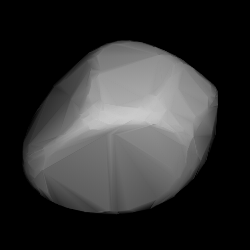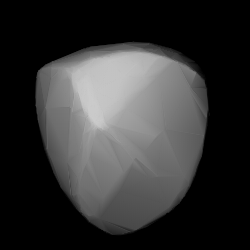Related Research Articles
978 Aidamina, provisional designation 1922 LY, is a dark background asteroid from the outer region of the asteroid belt, approximately 79 kilometers in diameter. It was discovered by astronomer Sergey Belyavsky in 1922, and later named after Aida Minaevna, a friend of the discoverer's family.
1203 Nanna is a carbonaceous asteroid from the outer region of the asteroid belt, about 35 kilometers in diameter. It was discovered on 5 October 1931, by German astronomer Max Wolf at Heidelberg Observatory in southwest Germany, and named after Anna Risi, a model and mistress of painter Anselm Feuerbach.

1110 Jaroslawa is a bright background asteroid and rather slow rotator from the inner regions of the asteroid belt. The stony S-type asteroid has a rotation period of 97.4 hours and measures approximately 13 kilometers in diameter. It was discovered at the Simeiz Observatory on the Crimean peninsula on 10 August 1928, by astronomer Soviet Grigory Neujmin, who named it after his son, Jaroslav Grigorevich Neujmin.
1151 Ithaka, provisional designation 1929 RK, is a carbonaceous asteroid from the inner regions of the asteroid belt, approximately 14 kilometers in diameter. It was discovered by Karl Reinmuth at the Heidelberg-Königstuhl State Observatory in 1929, and later named for the Greek island of Ithaca.
(9928) 1981 WE9, provisional designation 1981 WE9, is a stony Florian asteroid from the inner regions of the asteroid belt, approximately 3 kilometers in diameter. It was discovered on 16 November 1981, by astronomers at Perth Observatory in Bickley, Australia.

3015 Candy is a background asteroid from the outer regions of the asteroid belt, approximately 25 kilometers in diameter. It was discovered on 9 November 1980, by British-American astronomer Edward Bowell at Anderson Mesa Station in Flagstaff, Arizona. The asteroid was named after British astronomer Michael P. Candy.
1194 Aletta, provisional designation 1931 JG, is a carbonaceous asteroid from the outer region of the asteroid belt, approximately 55 kilometers in diameter. It was discovered on 13 May 1931, by South African astronomer Cyril Jackson at Johannesburg Observatory in South Africa. It was later named after the discoverer's wife Aletta Jackson.
5806 Archieroy, provisional designation 1986 AG1, is a stony Hungaria asteroid from the inner regions of the asteroid belt, approximately 6 kilometers in diameter. It was discovered on 11 January 1986, by American astronomer Edward Bowell at Lowell's Anderson Mesa Station near Flagstaff, Arizona. It is named after Scottish astrophysicist Archie Roy.
3737 Beckman, provisional designation 1983 PA, is a stony asteroid and sizable Mars-crosser on an eccentric orbit from the inner regions of the asteroid belt, approximately 14 kilometers in diameter. It was discovered on 8 August 1983, by American astronomer Eleanor Helin at the Palomar Observatory in California. The S-type asteroid has a rotation period of 3.1 hours. It was named for American Chemist Arnold Beckman.
6296 Cleveland, provisional designation 1988 NC, is a Hungaria asteroid from the innermost regions of the asteroid belt, approximately 3.5 kilometers in diameter. It was discovered on 12 July 1988, by American astronomer Eleanor Helin at the Palomar Observatory in California. The presumed E-type asteroid has a long rotation period of 30.8 hours and possibly an elongated shape. It was named for the city of Cleveland in the U.S. state of Ohio.
2093 Genichesk, provisional designation 1971 HX, is a Baptistina asteroid from the inner regions of the asteroid belt, approximately 12 kilometers in diameter. It was discovered on 28 April 1971, by Russian astronomer Tamara Smirnova at the Crimean Astrophysical Observatory in Nauchnyj, on the Crimean peninsula. It was named for the Ukrainian town Henichesk.
3800 Karayusuf, provisional designation 1984 AB, is a Mars-crossing asteroid and suspected binary system from inside the asteroid belt, approximately 2.5 kilometers in diameter. It was discovered on 4 January 1984, by American astronomer Eleanor Helin at the Palomar Observatory in California. The S/L-type asteroid has a short rotation period of 2.2 hours. It was named after Syrian physician Alford Karayusuf, a friend of the discoverer.
5641 McCleese, provisional designation 1990 DJ, is a rare-type Hungaria asteroid and slow rotator, classified as Mars-crosser from the innermost regions of the asteroid belt, approximately 4 kilometers in diameter.
3401 Vanphilos, provisional designation 1981 PA, is a stony, eccentric asteroid and sizeable Mars-crosser, approximately 7 kilometers in diameter. It was discovered on 1 August 1981, by and at Harvard's Oak Ridge Observatory in Massachusetts, United States.
1511 Daléra, provisional designation 1939 FB, is an asteroid from the inner regions of the asteroid belt, approximately 12 kilometers in diameter. It was discovered on 22 March 1939, by French astronomer Louis Boyer at the Algerian Algiers Observatory, North Africa, and named after Paul Daléra, a friend of the discoverer.

3674 Erbisbühl is an stony asteroid and one of the largest Mars-crossers from the innermost regions of the asteroid belt, approximately 11 kilometers in diameter. It was discovered on 13 September 1963, by German astronomer Cuno Hoffmeister at his Sonneberg Observatory on Mount Erbisbühl in Eastern Germany.
1708 Pólit, provisional designation 1929 XA, is a very dark asteroid from the outer region of the asteroid belt, approximately 29 kilometers in diameter. It was discovered on 30 November 1929, by Spanish astronomer of Catalan origin Josep Comas i Solà at the Fabra Observatory in Barcelona, and was later named after Catalan astronomer Isidre Pòlit i Boixareu.

1600 Vyssotsky, provisional designation 1947 UC, is a rare-type Hungaria asteroid and suspected interloper from the inner regions of the asteroid belt, approximately 7 kilometers in diameter. It was discovered on 22 October 1947, by American astronomer Carl Wirtanen at Lick Observatory in California, United States. It was named after astronomer Alexander Vyssotsky.
20936 Nemrut Dagi is a stony Hungaria asteroid and Mars-grazer from the innermost regions of the asteroid belt, approximately 3.5 kilometers in diameter. It was discovered on 13 May 1971, by Dutch astronomer couple Ingrid and Cornelis van Houten at Leiden, on photographic plates taken by Dutch–American astronomer Tom Gehrels at Palomar Observatory in California, United States. The asteroid has a rotation period of 3.28 hours, a likely spheroidal shape, and a high albedo typically seen among the enstatite-rich E-type asteroids. In 2012, it was named after the a dormant volcano Nemrut in Turkey.
(90075) 2002 VU94 (provisional designation 2002 VU94) is an asteroid on an eccentric orbit, classified as near-Earth object and potentially hazardous asteroid of the Apollo group, approximately 2.5 kilometers in diameter. It was discovered on 13 November 2002, by astronomers of the Near-Earth Asteroid Tracking program at Palomar Observatory in California, United States. It is one of the largest potentially hazardous asteroids known.
References
- 1 2 3 4 5 6 "JPL Small-Body Database Browser: 6500 Kodaira (1993 ET)" (2017-06-05 last obs.). Jet Propulsion Laboratory . Retrieved 21 June 2017.
- 1 2 3 4 Schmadel, Lutz D. (2007). "(6500) Kodaira". Dictionary of Minor Planet Names – (6500) Kodaira. Springer Berlin Heidelberg. p. 537. doi:10.1007/978-3-540-29925-7_5911. ISBN 978-3-540-00238-3.
- 1 2 3 "6500 Kodaira (1993 ET)". Minor Planet Center. Retrieved 2 May 2016.
- 1 2 3 4 5 6 "LCDB Data for (6500) Kodaira". Asteroid Lightcurve Database (LCDB). Retrieved 2 May 2016.
- 1 2 3 Nugent, C. R.; Mainzer, A.; Masiero, J.; Bauer, J.; Cutri, R. M.; Grav, T.; et al. (December 2015). "NEOWISE Reactivation Mission Year One: Preliminary Asteroid Diameters and Albedos". The Astrophysical Journal. 814 (2): 13. arXiv: 1509.02522 . Bibcode:2015ApJ...814..117N. doi:10.1088/0004-637X/814/2/117. S2CID 9341381 . Retrieved 26 October 2016.
- 1 2 3 Waszczak, Adam; Chang, Chan-Kao; Ofek, Eran O.; Laher, Russ; Masci, Frank; Levitan, David; et al. (September 2015). "Asteroid Light Curves from the Palomar Transient Factory Survey: Rotation Periods and Phase Functions from Sparse Photometry". The Astronomical Journal. 150 (3): 35. arXiv: 1504.04041 . Bibcode:2015AJ....150...75W. doi:10.1088/0004-6256/150/3/75. S2CID 8342929 . Retrieved 2 May 2016.
- 1 2 Clark, Maurice (October 2011). "Asteroid Lightcurves from the Preston Gott and McDonald Observatories". The Minor Planet Bulletin. 38 (4): 187–189. Bibcode:2011MPBu...38..187C. ISSN 1052-8091 . Retrieved 2 May 2016.
- 1 2 Stephens, Robert D. (April 2015). "Asteroids Observed from CS3: 2014 October - December". The Minor Planet Bulletin. 42 (2): 104–106. Bibcode:2015MPBu...42..104S. ISSN 1052-8091 . Retrieved 2 May 2016.
- 1 2 Clark, Maurice (March 2007). "Lightcurve Results for 1318 Nerina, 222 Lermontov 3015 Candy, 3089 Oujianquan, 3155 Lee, 6410 Fujiwara, 6500 Kodaira, (8290) 1992 NP, 9566 Rykhlova, (42923) 1999 SR18, and 2001 FY". The Minor Planet Bulletin. 34 (1): 19–22. Bibcode:2007MPBu...34...19C. ISSN 1052-8091 . Retrieved 2 May 2016.
- ↑ Veres, Peter; Jedicke, Robert; Fitzsimmons, Alan; Denneau, Larry; Granvik, Mikael; Bolin, Bryce; et al. (November 2015). "Absolute magnitudes and slope parameters for 250,000 asteroids observed by Pan-STARRS PS1 - Preliminary results". Icarus. 261: 34–47. arXiv: 1506.00762 . Bibcode:2015Icar..261...34V. doi:10.1016/j.icarus.2015.08.007. S2CID 53493339 . Retrieved 2 May 2016.
- ↑ "JPL Small-Body Database Search Engine: spec. type: B (SMASSII)". JPL Solar System Dynamics . Retrieved 1 January 2006.
- ↑ "MPC/MPO/MPS Archive". Minor Planet Center. Retrieved 2 May 2016.